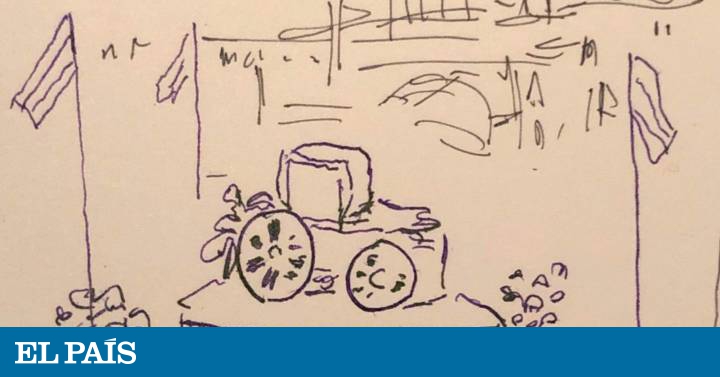More information
Without her- The cough of the world
- Home
The immense stone carriage was abandoned on the Paseo de Recoletos; They say that the Phrygian goddess shut herself up in an Alcalá bar upstairs and that the lions went in search of the bear that gets drunk all its life with the sloes of a strawberry tree. At the next roundabout, there are those who saw Neptune throw his trident and drown in the fountain until further notice ... And so, the horse that balanced Galileo in front of the Royal Palace has been left without a rider, the same as the stallion in the Plaza Mayor that rounds on the cobblestones looking for grass because the bronze monarch he was carrying was hidden in an old shop of caps and hats. Because of the alarm and the emergency, for fear of contagion and saturation of the serums and beds in all the hospitals, more than five million Madrilenians - born or adopted, putative or travelers - have had to lock ourselves in our respective loft until the Plague.
Running out of Madrid sounds like sin. It's without always being so close to the El Retiro park and not walking it daily with the silent soliloquy of the illusions that clean guilt, as a sin is not to visit the Train Museum in Delicias and imagine trips in sepia to a time of daring kisses A century ago when cholera also soured other people's sneezes. It is a sin not to be able to taste a boiling broth in Lhardy's antechamber bar like a Galdós or to ask for the usual table, red checkered tablecloth, in Casa Salvador and always try for the first time the stew soup that San Fernando puts in the plate, in the same corner where Hemingway and Ava Gardner ate and it is an unforgivable sin not to be able to carpe the Gran Vía with carnations and that Cascorro has left a gasoline can on its pedestal, so close to where Agustín Lara vanished in the shade in Lavapiés.
Now that it can't be done, I miss the rosary of those who tangle more than the blinds to answer the simplest questions and miss the colloquy of imbecilities as a handful of bus travelers take to the streets - loud and in unison - their theories of everything and nothing. Now that they have closed it, they want to see the sunrise in the Plaza de Malasaña or embrace the first walker who comes across the Parque del Oriente. Two weeks or two months from now, anchored in paragraphs of solitude and silence, the hermit is forced to imagine what was taken for granted: sneezing in the silence of the National Library without immediate condemnation of quarantine or coughing in the Subway car that is about to enter Bilbao without the rest of the union leaving in terror. They will lengthen the days dreaming or imagining that we put our hands to our faces, pressing our cheeks in the inconceivable astonishment that a Chilean goal has produced in the Bernabéu or that we caress the eyelid of a loved eye in the darkness of the Renoir cinema or that We pass the fingertip over the tip of the nose to the beautiful girl who wears glasses at three years old who never tires of laughing in the sun.
A beautiful painting by the painter José Manuel Ballester hangs in the Guggenheim in Bilbao where the endearing canvas by Diego Velázquez we know as Las Meninas has taken part . It seems prophetic: Ballester cloned Velázquez without characters. He concentrated on the empty space, on the perspective and the light, the depth and the angles of the view itself, but without reproducing the Infantita who is about to take a chocolate cup in a New Spanish clay cup, or the dwarf Maribárbola, Neither the dog nor the elf, nor the Kings in the mirror, nor the mysterious man in the background who seems to be entering because he is actually leaving. Velázquez no longer appears in Ballester's painting and he named it the Royal Palace, perhaps without imagining that a Friday 13 of a leap year would come with another pandemic that hit the world in the year 20, like a century ago and two and three years ago ... The real thing –Not royalty, but reality –that freezes our skin today and makes our saliva sour, here where there is nobody and yet we are all there; the real of fear and the ease of spreading a flu that can also kill. The terrible reality that all the paintings that fill our eyes are veiled or the paragraphs of so many novels that constitute us are erased. I had already received an ingenious meme of Leonardo Da Vinci's Last Supper without diners as soon as they declared Milan closed and then, Italy as a whole, perhaps as a warning of what awaits us or as a joke to laugh at any quarantine, but the Ballesteros painting It is a photographic print on canvas that now cannot be seen in Bilbao because the Guggenheim has closed, it strikes the conscience as a warning of the future: the Royal Palace where we live is much more fragile than demagogues and politicians imagine. In the palpable reality where Velázquez painted himself to see us all directly, there is no one or nothing left around him. It is laughable. It made me cry.
You can follow EL PAÍS Opinion on Facebook, Twitter or subscribe here to the Newsletter.






/cloudfront-eu-central-1.images.arcpublishing.com/prisa/XRGFNTFZXNHG5PPLCVK3ZYVK4I.jpg)


